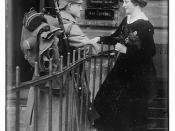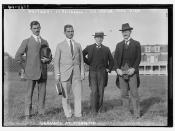History assignment- Discuss the flourishing cultural successes of Weimar Germany from 1924~1929
1924~1929 was recognized as "The Golden age of Weimar Germany"; hyperinflation was eased by the introduction of "Reich mark", unemployed population was lowered by a considerable proportion, reparation was eased, reconstruction was successful...Weimar Germany was in an era of tranquility. During that period of time, Germany developed its cultural entertainment greatly, especially in the areas of art, literature and film. But the developments all had a unanimous topic- they were almost all about war.
The art in Weimar Germany was a bit dark since World War I just washed over Europe, the art pieces were all quite abstract, and the two representatives of this art style would be Paul Klee and Otto Dix. Paul Klee (1879~1940) was a Swiss artist that was famous for his abstract art of expressionism (using symbols to express the artists emotions, originated in Germany); his pieces often include numbers and letters to blur the emotions in them, special effects such as mosaic were also applied in his work.
His abstract style greatly influenced latter artists that followed the rules of expressionism. Otto Dix (1891~1969) was a German expressionist that obtained fame for his direct, anti-war style; his strong emotions towards war were all expressed on his pieces. Symbolization was often seen in Otto Dix's art, his pieces often contain dark images such as a skull or a skeleton on the battlefield, the symbolism in his pieces are more direct than Paul Klee's, and his pictures of battlefields were more accurate than other artists since he experienced World War I as a soldier.
The literature in Weimar Germany is rather difficult to describe; there were numerous topics with different types of structure for different types of...


